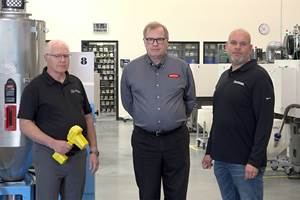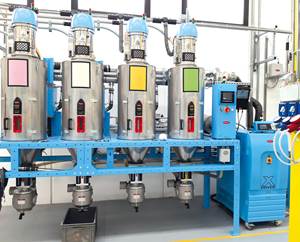PET Dryer Is Said to Cut Energy Use by 67%
A new method of recycling hot exhaust air back into the drying hopper of a wheel-type desiccant-rotor dryer is said to reduce energy consumption in high-volume PET processing by up to 67% relative to other desiccant dryers.
A new method of recycling hot exhaust air back into the drying hopper of a wheel-type desiccant-rotor dryer is said to reduce energy consumption in high-volume PET processing by up to 67% relative to other desiccant dryers. Substantial energy savings reportedly were verifi ed in beta testing by a large PET bottle maker of the new EnergySmart system from Conair, Pittsburgh. This system is an add-on option to the Carousel Plus desiccant-rotor dryer. Because it adds some complexity and expense, the EnergySmart option is recommended mainly for processors running large volumes (800 lb/hr or more) of hygroscopic materials that require drying at temperatures above 250 F. Besides PET, suitable applications could include polycarbonate sheet or film extrusion. In PET preform and bottle molding, resin is dried at 300 to 350 F for 4 to 6 hr in hoppers holding thousands of pounds. In a standard PET dryer, exhaust air leaving the hopper is still quite hot-around 200 F. Because the desiccant is less able to remove moisture at such temperatures, the air must pass through a water-cooled heat exchanger to drop the temperature to about 120 F. Thus about 80° F of heat energy is wasted. What's more, the air must be reheated to 350 F after it passes through the desiccant but before it reenters the drying hopper. Conair's EnergSmart system reduces this waste by means of a twostage system incorporating a hot-air drying circuit and a dehumidifi ed air circuit. Some of the 200 F return air leaving top of the drying hopper is channeled through a dust fi lter and then reheated to 350 F before it is reintroduced to the drying hopper via a special inlet cone in the center of the hopper about halfway from the bottom. "This recycled air is not quite as dry as normal drying process air," explains Pete Stoughton, PET sales manager. "Its dewpoint is between -20 and 0°F instead of the -40 F resin manufacturers recommend. But the main function of the recirculated hot air is to preheat the polymer in the top half of the hopper to the drying temperature." The low-dewpoint drying air required for PET is supplied by the EnergySmart system's dehumidifi ed air circuit. That -40 F dewpoint air is heated to 350 F and introduced to the center of the hopper at the bottom through an inlet cone in the tube-intube air distribution system. "Because we have preheated the PET to the drying temperature in the hot-air section of the hopper," says Stoughton, "we need a considerably smaller volume of desiccated air in the dehumifying zone. We need less energy to heat a smaller volume of air, and we can use a smaller dryer." Conair says this system can save $3.05/1000 lb of PET, based on an electricity cost of 5.5¢/kwh. The volumes of recirculated hot air and dehumidifi ed air are adjusted in the EnergySmart system by the Conair Drying Monitor. A long probe in the drying hopper has six temperature sensors to monitor different zones. The hopper temperature profi le is continuously displayed on the operator screen. Tel: (412) 312-6000 . www.conair.com
Conair
One Conair Dr. Pittsburgh, PA 15202
Phone (412) 312-6000 Fax (412) 312-6320
Related Content
Captive Molder Beefs Up Auxiliaries to Boost Quality, Consistency
SeeScan adds conveying, drying, feeding and chilling technologies to improve quality — and enhance employee safety — in production of its underground/underwater inspection systems.
Read MoreFinding Efficiencies in How Components Work Together
Auxiliary systems are vital to the proper functioning of a plastic processing line, and they can be a source of major cost and efficiency improvements.
Read MoreBozzelli’s Guide To Specifying a Dryer
Here's a list of 17 things to do when looking for new drying equipment.
Read MoreAI Manages Resin Drying Airflows and Throughputs for Energy Savings
NPE2024: Optional feature automates the process of maintaining process-ready resins at perfect temperatures and varied throughputs, while preventing overdrying and realizing significant energy savings.
Read MoreRead Next
Why (and What) You Need to Dry
Other than polyolefins, almost every other polymer exhibits some level of polarity and therefore can absorb a certain amount of moisture from the atmosphere. Here’s a look at some of these materials, and what needs to be done to dry them.
Read MoreLead the Conversation, Change the Conversation
Coverage of single-use plastics can be both misleading and demoralizing. Here are 10 tips for changing the perception of the plastics industry at your company and in your community.
Read MoreAdvanced Recycling: Beyond Pyrolysis
Consumer-product brand owners increasingly see advanced chemical recycling as a necessary complement to mechanical recycling if they are to meet ambitious goals for a circular economy in the next decade. Dozens of technology providers are developing new technologies to overcome the limitations of existing pyrolysis methods and to commercialize various alternative approaches to chemical recycling of plastics.
Read More








